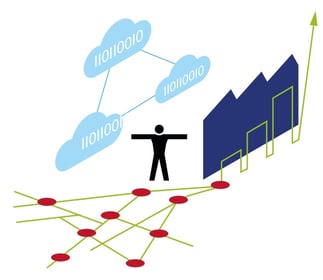The Impact of Cognitive Analytics on the Automotive Supply Chain
Brian Hoey - September 11, 2018

 IT pioneer and philosopher Ted Nelson, who coined the term hypertext, once famously said, "The good news about computers is that they do what you tell them to do. The bad news is that they do what you tell them to do." Historically, in the automotive supply chain, this couldn’t be more true. New technological developments like early computerized workflows and simple process automation were hampered by information silos and integration issues not because the technology lacked sophistication, but because they still had to be told what to do in very specific ways.
IT pioneer and philosopher Ted Nelson, who coined the term hypertext, once famously said, "The good news about computers is that they do what you tell them to do. The bad news is that they do what you tell them to do." Historically, in the automotive supply chain, this couldn’t be more true. New technological developments like early computerized workflows and simple process automation were hampered by information silos and integration issues not because the technology lacked sophistication, but because they still had to be told what to do in very specific ways.
This is, in some ways, the nature of all tools—but what if it were possible for computers and software platforms to be less like tools and more like trusted partners? That's the way that people are talking about cognitive analytics, especially in the context of the supply chain. But what exactly does this term mean, and what implications will the existence of this technology have on the automotive supply chain in particular?
What is Cognitive Analytics?
To a certain extent, cognitive analytics is something of a catchall term. Rather than referring to one cohesive idea, the term is used to discuss machine learning (ML), artificial intelligence (AI), and natural language processing (NLP) somewhat interchangeably. Even in their developmental stages these technologies are already having a widespread impact on the way that we interact with our technology—they’re already starting to impact supply chain management within the automotive sector, providing planners with insights and opportunities for optimization across a wide array of workflows. Because of this, experts are touting their transformative effects, with some envisioning uses so broad and sweeping that it's almost impossible to envision how a business would actually implement cognitive analytics into existing workflows.
Luckily, businesses can and should think of cognitive analytics, at least somewhat, as though it were a tool like any other. This means utilizing the technology for a clear, specific business purpose and giving it some initial instructions. The relevant difference, however, and the reason their uses often come across as overly lofty or intimidating, is that cognitive analytics tools need less instruction over time, and in fact continue improving as you use them. Nowhere is this effect more powerful than in forecasting workflows, in which machine learning processes can automate the aggregation of mission critical data into usable prescriptive insights.
Where earlier forecasting processes relied largely on historical data, and were thus incapable of accounting for impending changes in market forces, modern analytics platforms are increasingly able to identify the complex array of parameter (from tariffs and price hikes to shifting demand levels for component materials like aluminum and glass) that influence market trends. The result is a process that is at once highly autonomous (i.e. not requiring much input from users) and extremely visible, allowing planners to examine and analyze data in real time.
Cognitive Analytics and Industry 4.0
In an industrial context, cognitive analytics processes go hand in hand with Industry 4.0 systems. The rise of the smart factory is expected to lead to increased product customization and shortened lead-times for product launches. Owing to the vast and increasing complexity of the average car, these two goals can seem particularly daunting in the automotive industry. Let’s say that you’re in charge of the team that’s rolling out a new model of one of your top selling cars. Right now, each design choice you make requires new calculations about part and material availability and demand changes, to say nothing of the complexities of any changes that your production stream may have to undergo. In a pre-analytics landscape, you’d be working with a limited amount of historical data, and otherwise trusting your gut. As a result, you could easily find yourself in a situation in which your inventory of parts or completed automobiles is out of sync with demand, resulting in either costly additional storage expenses or potential bottlenecks and shortages.
In the world of cognitive analytics, on the other hand, your analytics tools could more accurately predict customer and market behavior using sales history, past customer behavior, individual part data, and other carefully segmented data sources. As a result, you could begin optimizing your process in the design stage, selecting features and implementing designs that will best fit into your market predictions and production processes, before moving on to inventory optimization. Rather than relying on guesswork in determining your production ratios and warehouse utilization, you could use granular levels of demand sensing to reduce inventory carrying costs and drive towards a leaner supply chain overall. Optimized workflows like these are obviously ends in and of themselves, but they also represent the foundation of the new industrial workflows that are emerging as part of the so-called fourth industrial revolution.
Fulfillment and Logistics
Up to this point, we’ve seen how advanced analytics processes can smooth out the automotive supply chain before a product is even conceived. But what happens after the product has been produced and is ready to make its journey to the customer? First off, cognitive analytics processes can help manufacturers to optimize their logistics costs by suggesting routes and freight packaging strategies based on real-time updates. Perhaps more importantly, however, these modern analytics workflows can also help to empower proactive steps against bottlenecks and breakdowns by identifying the risk levels inherent in certain routes or the volatility of certain costs.
If you’re managing your company’s transport logistics, these capabilities mean that when you’re choosing between various transport options, you’ll be able to visualize the likely outcome of each one and make your decision accordingly. In this way, you can choose the optimal path for your products to take from the factory floor to the customer, both in terms of ensuring on-time delivery and minimizing transport costs. Cognitive analytics processes may still just be a tool—but moving forward they’ll become an increasingly versatile and important tool in the ever-evolving automotive supply chain. More than that, they'll become a key element of Industry 4.0 systems, meaning that in the future they likely will be used in ways that we haven't even imagined yet. Whatever those uses are, it will be the early adopters of this technology who benefit the most when they arise.
LATEST POSTS
- Understand Circular Economy in The Manufacturing Industry
- How Can Industry 4.0 IT Integration Be Achieved Smoothly?
- The Significance of Order Sequencing in Discrete Manufacturing
- How to improve your Supply Chain Management: The Power of Control Towers
- Optimizing Human Resource Scheduling in Manufacturing: A Technological Approach



